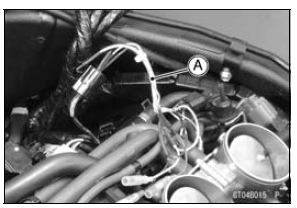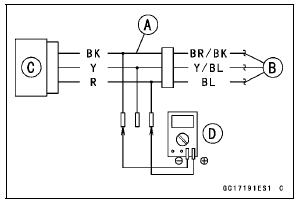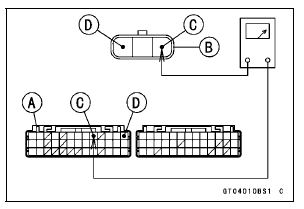

NOTE
Be sure the battery is fully charged.
[B] Main Harness
[C] Intake Air Pressure Sensor #1
Special Tool - Measuring Adapter: 57001-1700


Intake Air Pressure Sensor #1 Input Voltage Connections to Adapter: Digital Meter (+) → R (sensor BL) lead Digital Meter (–) → BK (sensor BR/BK) lead
Input Voltage Standard: DC 4.75 ∼ 5.25 V
If the reading is within the standard, check the output voltage (see Intake Air Pressure Sensor #1 Output Voltage Inspection).
If the reading is out of the standard, remove the ECU and check the wiring for continuity between main harness connectors.
Special Tool - Hand Tester: 57001-1394
Disconnect the ECU and sensor connectors.

Wiring Continuity Inspection ECU Connector [A] ←→ Intake Air Pressure Sensor #1 Connector [B] BL lead (ECU terminal 9) [C] BR/BK lead (ECU terminal 13) [D]
If the wiring is good, check the ECU for its ground and power supply (see ECU Power Supply Inspection in the Fuel System (DFI) chapter).
If the ground and power supply are good, replace the ECU (see ECU Removal/Installation in the Fuel System (DFI) chapter).
 Intake Air Pressure Sensor #1 Installation
Intake Air Pressure Sensor #1 Installation Intake Air Pressure Sensor #1 Output Voltage Inspection
Intake Air Pressure Sensor #1 Output Voltage InspectionPrecautions
1) No need of topping-up
No topping-up is necessary in this battery until it ends its life under
normal use. Forcibly prying
off the seal cap to add water is very dangerous. Never do that.
2) Refreshing charge.
Give refresh charge for 5 to 10 hours with charge current shown in the text
(see ...
Brake Pedal Installation
Apply grease to the brake pedal pivot shaft [A].
Install:
Washers [B]
Brake Pedal [C]
Apply a non-permanent locking agent to the threads of
the brake pedal mounting bolt [D], and tighten it.
Torque - Brake Pedal Mounting Bolt: 8.8 N·m (0.90 kgf·m,
78 in·lb)
Install the re ...
Coolant Reserve Tank Installation
Install the following to the coolant reserve tank [A].
Pad [B]
Gasket [C]
Cap [D]
Collar [E]
Install the coolant reserve tank and tighten the bolt [F].
Run the hoses correctly (see Cable,Wire, and Hose Routing
section in the Appendix chapter).
Fill the coolant reserve tank with ...